Library
All resources
2141 – 2160 of 2404 results

Emergency Food Security and Livelihoods (EFSL) 48-hour Assessment Tool
Guidelines and Tools
The purpose of the 48-hour assessment tool is to obtain a quick understanding of the emergency food security and livelihood (EFSL) situation within the first few days after a rapid-onset disaster. Initially developed by Oxfam, this tool aims to support response teams to meet requirements in emergencies in...

An Emergency Market Mapping and Analysis study Changing Responses to the Haiti Earthquake
Report
Good practice standards guidelines and evaluations all emphasise the importance of including markets in emergency situation and response analysis. While this approach has become more widely accepted by international organisations in recent years, in practice it is clear that support is still needed to...

Examining Differences in the Effectiveness and Impacts of Vouchers and Unconditional Cash Transfers
Report
The objective of this study is to examine the differences in the effectiveness and impacts of vouchers versus unconditional cash transfers in the Bushani camp of the Masisi territory of the Democratic Republic of Congo. As part of this research, the study team collected household data from over...

Comparative Review of Market Assessments Methods, Tools, Approaches and Findings – SWOT Analysis
Guidelines and Tools
This document makes a comparative review of different market assessments methods,tools, approaches and findings. A swot analysis of the Emergency Market Mapping Analysis (EMMA), Market Information and Food Insecurity Response Analysis (MIFIRA) and World Food Programme Trader Survey (WFP TS) is...
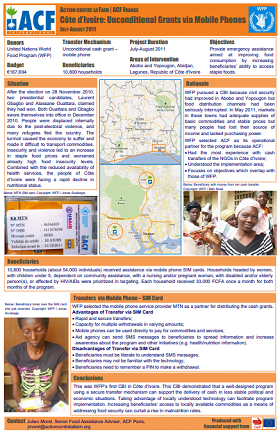
ACF Côte d’Ivoire: Unconditional grants via mobile phones (poster)
Report
This one-pager (poster) provides an overview of ACF’s experience transferring cash by mobile phone in the Ivory Coast (a WFP programme).

Emergency Food Security and Livelihoods (EFSL) 48-hour Facilitator’s Materials
Guidelines and Tools
Developed by Oxfam and supporting ECB agencies, the EFSL training materials can be used to train participants to confidently apply the ‘48-hour assessment tool’ to assess the impact of a shock/hazard on an affected population’s food security and livelihoods. The Facilitator Materials include session...
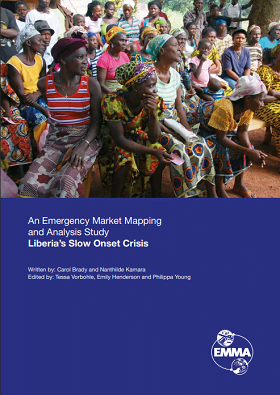
An Emergency Market Mapping and Analysis Study Liberia’s Slow Onset Crisis
Report
In 2010, contested elections in neighbouring Côte d’Ivoire, and the violence that ensued, forced hundreds of thousands of people from their homes. As of 7th of July 2011, the United Nations High Commissioner for Refugees (UNHCR) had counted a total of 153,000 refugees crossing the border into Liberia....

Emergency Food Security and Livelihoods (EFSL) 48-hour training materials to print
Guidelines and Tools
Developed by Oxfam and supporting ECB agencies, the EFSL training materials can be used to train participants to confidently apply the ‘48-hour assessment tool’ to assess the impact of a shock/hazard on an affected population’s food security and livelihoods. This resource includes all printing...

ACF Meta Evaluation: Fresh food vouchers (poster)
Report
This one-page poster shows a summary of the meta evaluation of 5 Fresh Food Voucher programmes in Bolivia, Haiti, Daadab Kenya, the oPT and Pakistan.

An Emergency Market Mapping and Analysis study Market Support in South Sudan
Report
Abyei is a relatively small and disputed area of land on the border of North and South Sudan that has, in recent years, experienced much turmoil. Historically, both the governments of South and North Sudan have claimed Abyei and tensions that have existed since before the first Sudanese Civil War...
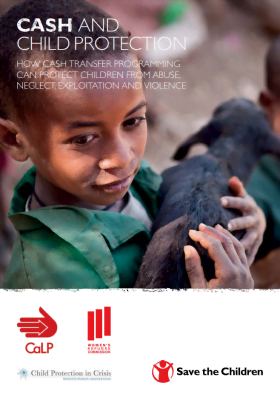
Cash and Child Protection: How cash transfer programming can protect children from abuse, neglect, exploitation and violence
Guidelines and Tools
This discussion paper examines the links between cash transfers and the positive and negative outcomes for children – in particular, the role cash transfers have played in protecting children from abuse, neglect, exploitation and violence. It aims to identify ways in which cash transfer activities could...
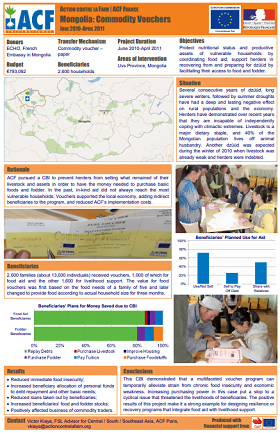
ACF Mongolia Commodity Vouchers (Poster)
Report
This one-page poster provides an overview of ACF’s commodity voucher programme in Mongolia.

Child Safeguarding in Cash Transfer Programming
Guidelines and Tools
While cash transfers have become a key intervention in emergencies, they also pose increased and additional risks for beneficiaries, compared with other forms of assistance. Children are particularly vulnerable, and even more so in emergencies. The impact of cash transfer programming on children’s...

Annex 1: Multi-Sector Market Assessment (MSMA)
Report
The Multi-Sector Market Assessment (MSMA) Annex is designed to help practitioners examine whether an affected target population can fairly and equitably access the expected amount of goods and services in
order to meet the objectives of the Multipurpose Cash Grant (MPG) programme.
The aim of the MSMA is...
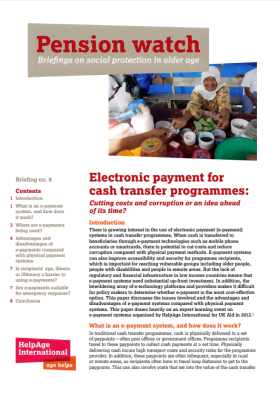
Pension Watch Briefing #8: Electronic payment for cash transfer programmes
Policy paper
There is growing interest in the use of electronic payment (e-payment) systems in cash transfer programmes. When cash is transferred to beneficiaries through e-payment technologies such as mobile phone accounts or smartcards, there is potential to cut costs and reduce corruption compared with physical...
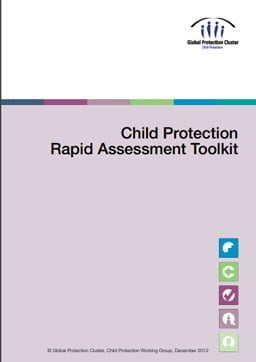
Child Protection Rapid Assessment Toolkit
Guidelines and Tools
The CPRA Toolkit provides all the information you need to conduct a CPRA over a five-week timeframe. The toolkit is divided into three parts: Part 1: a guide to CPRA provides an action plan with 6 key phases, giving guidance for tasks in each phase. Part 2: sample tools provides five key tools for...

New Technologies in Cash Transfer Programming and Humanitarian Assistance
Report
This study was commissioned by the the CALP Network in 2011, to review the current use of new technology in humanitarian cash and voucher programming and the broader implications for humanitarian practice. The research was undertaken to explore (i) preconditions for the use of technological...

New Technologies in Cash Transfer Programming and Humanitarian Assistance – Executive Summary
Report
This is the executive summary of the CALP Network’s research on new technologies in cash transfer programming and humanitarian assistance. For more, please see the full report.

Sample Cash Transfer Contract
Report
Sample Cash Transfer Contract
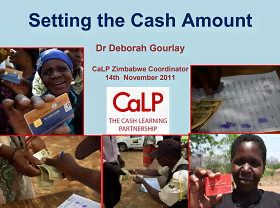
Setting the Cash Amount
Report
Setting the Cash Amount